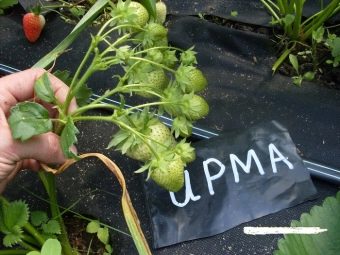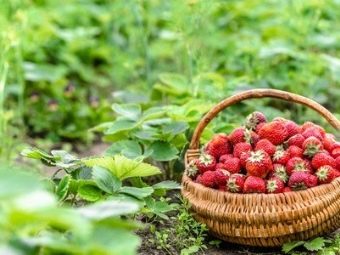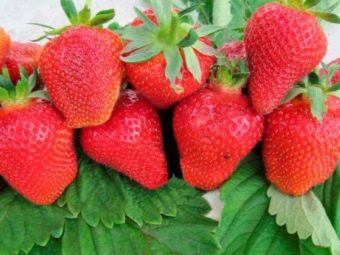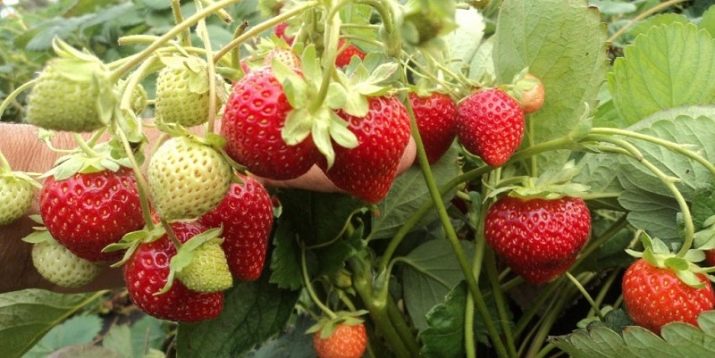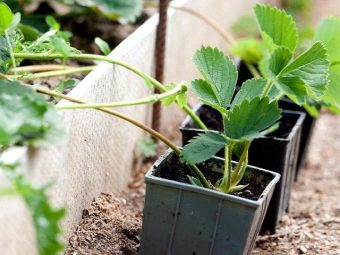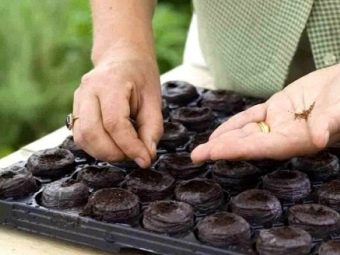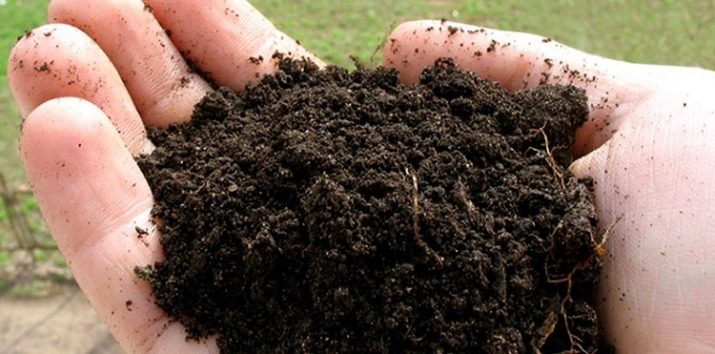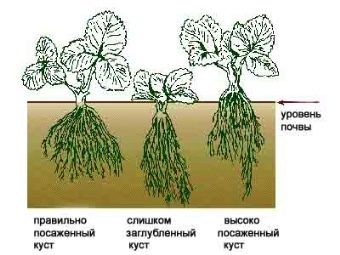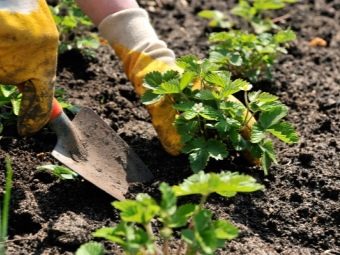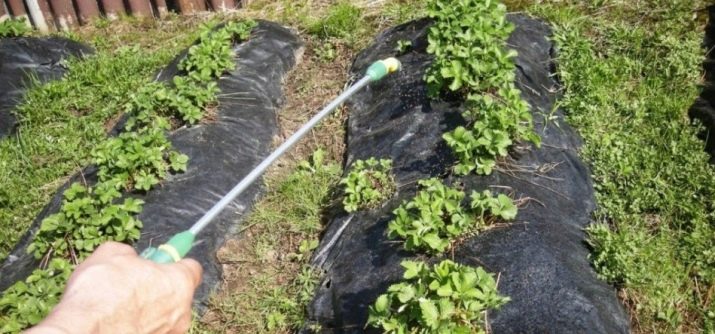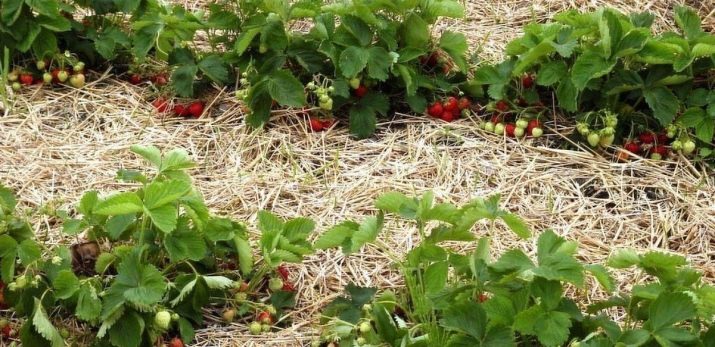Strawberry "Irma": characteristics of the variety and cultivation
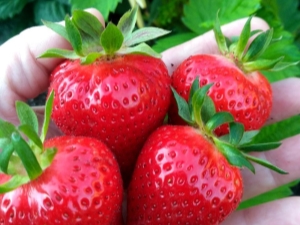
The repairing strawberry culture “Irma” is highly valued by breeders and gardeners simply because the period of its fruiting is four months.
The plant has many advantageous characteristics, and this makes it possible to use the variety in different climatic zones.
Description
This type of strawberry allows you to shoot more than three harvests in one season, and this is the main advantage of the plant. In this regard, it is quite clear commercial interest in this berry.
The growth and fruiting of strawberries does not actually depend on the length of the daylight, and the fruits appear quite early - in the second decade of June.
Distinctive characteristics of culture:
- berry bushes have a thin green massif, they are small, of medium height, they are compact, have developed roots;
- the variety has a moderate ejection of young shoots;
- leaves are large, dark green;
- peduncles long and high;
- fruits are large, juicy, bright scarlet, almost crimson, their weight reaches 35 grams, and sometimes more;
- the sugary, dense pulp has a dessert taste, and the present sourness is very delicate.
The largest number of berries can be harvested at the end of August, but the sugar content of the fruit is no longer the same as at the beginning of the season, besides, by the end of the fruiting, the size of the berries also decreases. Despite this, they contain a large amount of plant antioxidants, minerals and ascorbic acid. Strawberry "Irma" refers to the mid-early varieties and has its own characteristics:
- the sugar content of the berry remains even in rainy weather;
- pronounced strawberry flavor is absent;
- by the end of summer, the fruits lose their distinct cone-shaped outlines, and their sharp "nose" is rounded.
For full re-yields requires regular irrigation and mulching of the crop, as well as the introduction of suitable fertilizers.
The advantages and disadvantages of culture
Italian strawberries are extremely popular and are successfully cultivated in many southern European countries and in Russia.
The reason for this are the merits of a wonderful berry:
- consistently high yields that can be harvested several times during the fruiting period;
- Immunity to intense heat - the fruits remain juicy and sweet;
- high tasting rate of berries (up to 1 kg of product from the bush);
- simple way of breeding stepsons;
- cold resistance of bushes in cold weather;
- the dense structure of the fruit, allowing them to be stored and subjected to transportation;
- resistance to certain diseases and strawberry mite.
Among the shortcomings can be identified only a decrease in productivity by the end of the season, but, as a rule, this is due to prolonged heat. But in this case, the crop can be saved, if properly organize the system of irrigation and shading of fruit-bearing bushes.
In areas where rainy weather is not uncommon, berry bushes can wither, so strawberries should be grown in greenhouse conditions or re-planted.
Propagation by stepsons and seeds
The first question that arises from fans is how to propagate this sort of berry plant. Reviews of gardeners with experience in this field indicate that the easiest way to do this is to use strawberry mustaches.
This is done as follows:
- the strongest and most viable adult bushes are selected, and they have two most developed leaf plates rooted;
- after the development of the root system, they are separated from the parent plant.
You can grow strawberries from seed, although this is more troublesome. But so the grade will be guaranteed clean:
- planting material should be sown at the end of February or early March in nutrient boxes;
- they are planted shallowly, lightly dusted with soil;
- the container is covered with a glass lid or cellophane to create a microenvironment, but watering and ventilation are carried out regularly;
- in the tank it is necessary to maintain the temperature not lower than 19-20 degrees;
- it is important to provide seedlings with constant light;
- planting is necessary when the seedling has at least five leaves.
Before placing the seedlings, you need to take care of a suitable plot and soil.
How to grow?
Place for planting requires a lot of sun, protection from wind and drafts; seedlings can be placed in the southwestern part of the site.
For this variety of strawberries, most soil formulations are not suitable. The plant can not be planted in an excessively acidic and alkaline soil, it does not like sandy-clay soils. For culture suitable humus soil rich in organic matter or a soil with a high content of peat, which add lime, dolomite flour and sawdust.
A good site for planting will be the beds, previously used for greens, lettuce, radishes or legumes.
They dig up the ground with forks, removing weeds, debris, extraneous roots and stones from it, then it is desirable to fertilize it with chicken manure, compost, and mineral additives in the form of superphosphate and potassium chloride.
Planting is carried out in several stages:
- Planting provides two rows of seedlings with a bed width of 70-80 cm;
- the aisle should be about 40 cm;
- planting holes dig at a distance of 20 cm from the edge of the garden, depth - not less than 12 cm for free placement of the roots;
- in the pits fall asleep composition of a bucket of garden land, compost, which add half a liter of ash and two liters of humus;
- between saplings it is necessary to observe a distance of 50 cm;
- the root system is spread vertically;
- at the end they produce mulching with needles or sawdust.
Planting can be carried out in the spring, as well as at the end of summer, in the southern areas this can be done a little later, however, because of this, the yield of the next season may decrease.
How to care?
To obtain high yields, the crop needs simple, but regular care.
Main works include:
- daily watering, especially in hot weather;
- loosening the soil around the bush and between the rows, especially before the period of formation of the fruit;
- weed removal;
- covering the mulch will ensure the preservation of moisture required by the root system;
- the seedlings of the first year of planting cut off flower stalks, whiskers to stimulate growth;
- from insects and as a fertilizer, the leaves should be sprinkled with wood ash;
- late berries, ripening in the autumn, it is better to protect with agrofibre or a special film;
- in late autumn, pruning of damaged leaves and stepsons is done, soil is fertilized with peat and rotten foliage;
- in early spring and during the appearance of peduncles, it is necessary to introduce nitrogen and other mineral substances so that the growth of the ovaries and fruits does not slow down.
Soil mulching should be done in spring, when high humidity will help cause gray rot, in the fall it is important that the soil does not freeze together with strawberry roots. In addition, such agricultural work is carried out to ensure that there is no erosion and weathering of the soil, for free access of oxygen to the roots, and regulation of the temperature regime of the earth. It should take into account the flowering period in the southern regions - although the strawberry is resistant to dry climate, it needs intensive watering, mulching and shading, otherwise the fruiting will be significantly reduced. It is necessary to update the planting culture every 2-3 years, since remontant hybrids are subject to degeneration, which negatively affects the productivity of the variety.
Sometimes the yield decreases for no apparent reason, but they certainly exist.
- It may be too cold in winter or freezing, which makes the leaves darken. In this case, they should be covered with film.
- The use of insecticidal preparations also negatively affects the growth of strawberries - some time after treatment, it is desirable to spray the bushes with anise oil.
- Too late planting of the crop is another good reason why the plant does not bloom. It should be remembered that seedlings can be placed only until the end of July.
- Buds and newly formed ovaries may fall off due to the weevil, and then you will need to use special tools.
With good care, high-quality seedlings take root pretty quickly, but it is also necessary to make allowances for the region in which the berries are grown.
In the next video you will find an overview of the flowering strawberries variety "Irma".

